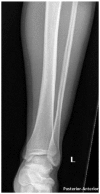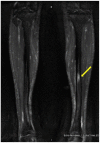Ultrasound-Diagnosed Tibia Stress Fracture: A Case Report
- PMID: 28469488
- PMCID: PMC5390922
- DOI: 10.1177/1179544117702866
Ultrasound-Diagnosed Tibia Stress Fracture: A Case Report
Abstract
Stress fractures are a frequent cause of lower extremity pain in athletes, and especially in runners. Plain imaging has a low sensitivity. Magnetic resonance imaging (MRI) or bone scan scintigraphy is the criterion standard, but expensive. We present the case of a young female distance runner with left shin pain. Plain radiography was unremarkable. Ultrasound showed focal hyperechoic elevation of the periosteum with irregularity over the distal tibia and increased flow on Doppler. These findings were consistent with a distal tibia stress fracture and confirmed by MRI. Examination of our case will highlight the utility of considering an ultrasound for diagnosis of tibial stress fracture.
Keywords: Stress fracture; tibia; ultrasound.
Conflict of interest statement
DECLARATION OF CONFLICTING INTERESTS: The author(s) declared no potential conflicts of interest with respect to the research, authorship, and/or publication of this article.
Figures





Similar articles
-
Role of Ultrasound in Early Diagnosis of Stress Fracture: A Case Report of Bilateral Distal Fibular Stress Fracture in a Female Recreational Badminton Player.J Am Podiatr Med Assoc. 2021 Feb 1;111(1):Article_9. doi: 10.7547/19-146. J Am Podiatr Med Assoc. 2021. PMID: 33690809
-
Magnetic resonance imaging in stress fractures and shin splints.Clin Orthop Relat Res. 2004 Apr;(421):260-7. doi: 10.1097/01.blo.0000126333.13806.87. Clin Orthop Relat Res. 2004. PMID: 15123957 Clinical Trial.
-
Scintigraphic characteristics of non-ossifying fibroma in military recruits undergoing bone scintigraphy for suspected stress fractures and lower limb pains.Nucl Med Commun. 2007 Jan;28(1):25-33. doi: 10.1097/MNM.0b013e328012e3de. Nucl Med Commun. 2007. PMID: 17159546
-
Stress fractures in athletes.Top Magn Reson Imaging. 2006 Oct;17(5):309-25. doi: 10.1097/RMR.0b013e3180421c8c. Top Magn Reson Imaging. 2006. PMID: 17414993 Review.
-
Stress fractures: pathophysiology, clinical presentation, imaging features, and treatment options.Emerg Radiol. 2016 Aug;23(4):365-75. doi: 10.1007/s10140-016-1390-5. Epub 2016 Mar 22. Emerg Radiol. 2016. PMID: 27002328 Review.
Cited by
-
Sonographic evaluation of spondylolysis: technique description and feasibility study of diagnostic ultrasound for the detection of L5 pars interarticularis fractures.J Can Chiropr Assoc. 2024 Aug;68(2):122-130. J Can Chiropr Assoc. 2024. PMID: 39318843 Free PMC article.
-
Ultrasound and bone: a pictorial review.J Ultrasound. 2020 Sep;23(3):227-257. doi: 10.1007/s40477-020-00477-4. Epub 2020 May 17. J Ultrasound. 2020. PMID: 32419074 Free PMC article. Review.
-
Preliminary image findings of lower limb stress fractures to aid ultrasonographic diagnoses: A systematic review and narrative synthesis.Ultrasound. 2021 Nov;29(4):208-217. doi: 10.1177/1742271X21995523. Epub 2021 Mar 9. Ultrasound. 2021. PMID: 34777541 Free PMC article. Review.
-
Tibia stress injury and the imaging appearance of stress fracture in juvenile dermatomyositis: six patients' experiences.Pediatr Rheumatol Online J. 2021 Feb 17;19(1):17. doi: 10.1186/s12969-021-00501-9. Pediatr Rheumatol Online J. 2021. PMID: 33596941 Free PMC article.
References
-
- Dobrindt O, Hoffmeyer B, Ruf J, et al. Blinded-read of bone scintigraphy: the impact on diagnosis and healing time for stress injuries with emphasis on the foot. Clin Nucl Med. 2011;36:186–191. - PubMed
-
- Papalada A, Malliaropoulos N, Tsitas K, et al. Ultrasound as a primary evaluation tool of bone stress injuries in elite track and field athletes. Am J Sports Med. 2012;40:915–919. - PubMed
-
- Reeder MT, Dick BH, Atkins JK, Pribis AB, Martinez JM. Stress fractures: current concepts of diagnosis and treatment. Sports Med. 1996;22:198–212. - PubMed
-
- Geslien GE, Thrall JH, Espinosa JL, et al. Early detection of stress fractures using 99mTC-polyphosphonate. Radiol. 1976;121:683–687. - PubMed
-
- Bianchi S, Luong DH. Stress fractures of the ankle malleoli diagnosed by ultrasound: a report of 6 cases. Skeletal Radiol. 2014;43:813–818. - PubMed
Publication types
LinkOut - more resources
Full Text Sources
Other Literature Sources

